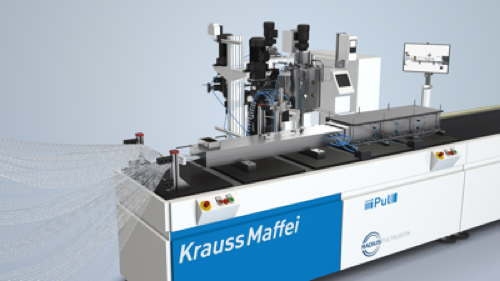New iPul pultrusion line increases productivity and cost-efficiency for straight and curved profiles. Technology targets applications in construction and wind power.
June 6, 2017

With a new approach, KraussMaffei Reaction Process Machinery wants to bring the pultrusion process for the uninterrupted production of highly filled, fiber-reinforced plastic components to a new performance level. The focus of development is on a new economic system solution, the iPul pultrusion system, which reportedly doubles the previous manufacturing speed.
|
New approach to fiber impregnation in pultrusion process can potentially double output rate |
"Up to now, [processing] speeds have usually been at 0.5 to 1.5 m/min. With the new KraussMaffei iPul system, our goal is to give production speed a significant boost and increase it to over 3 m/min," says Josef Renkl, Pultrusion Development Manager at KraussMaffei. As a result, the technology will open up completely new markets. Another supporting factor is the capacity of the technology to manufacture not only straight but also bent profiles in the radius pultrusion process.
The new pultrusion machines from KraussMaffei combine direct injection of the matrix material and the radius pultrusion process in a unique way. "Direct injection of the matrix material using a metering machine and an injection chamber offers clear technical and economic advantages compared with the typical market practice where impregnation is generally carried out by pulling the reinforcement through a bath", states Renkl.
An important component of the new machine is the metering technology which has been optimized especially for the pultrusion process. It injects the matrix material directly and continuously into the injection chamber. This means the matrix systems can work with a higher reactivity, which in turn can be specifically coordinated to the property patterns of the end product. Further, the current open resin bath where impregnation of the dry fibers must take place with the use of additional guide panels is omitted. In addition, the injection chamber supports the higher speeds required in production and is reportedly much more flexible and precise. For instance, the injection points can be easily and individually set and adjusted specific to the product.
Following the injection chamber, the impregnated fibers are pulled through a heated stationary die. The component is cured over several individually selectable heating zones to achieve the desired hardened state. A profile pulling unit transports the pultruded profile continuously through the machine at constant speed before it can be cut and assembled. All machine components can be operated centrally via a control system.
iPul pultrusion machines are capable of processing diverse matrix materials such as epoxy, polyurethane and in the future polyamide 6. Fibers made from glass, carbon, basalt, or aramid are mainly used as reinforcement fibers. It is also possible to directly work in additives such as mineral fillers, pigments or flame retardants. With the new iPul pultrusion machines both linear profiles with complex cross-sections, as well as 2D and 3D curved profiles, can be manufactured in the patented radius pultrusion process.
KraussMaffei is working closely with Thomas Technik, the inventor of radius pultrusion and an experienced supplier of pultrusion machines, which complement the metering machines from KraussMaffei perfectly.
Perfect for wind energy and construction
Pultruded profiles are characterized by their high fiber volume content and thus a high strength with low weight, making them suitable for use in the construction and wind power industries. Using the example of three select applications and in cooperation with partners from the chemicals industry, KraussMaffei demonstrates the feasibility and advantages of the new pultrusion machine. Polyurethane-based profiles for example for large- format windows with simultaneously narrow frames are the topic of the collaboration with Covestro. "Pultruded polyurethane profiles offer significantly better mechanical characteristics here than PVC profiles. The insulation properties are excellent, their production is cost-effective, mainly in comparison to common aluminum profiles. We see a huge future market here, particularly in public buildings, offices or other institutions", adds Wolfgang Hinz, Business Development Pultrusion at KraussMaffei. The second application example also comes from the construction industry.
Partner for the concrete project with epoxy resins and glass fibers is Evonik. The third application stems from the wind energy sector. Here it is about the production of pultruded reinforcement elements for particularly large-format rotor blades in wind turbines. "Together with our partner Huntsman, we are pushing the development of new epoxy materials and pultrusion equipment technology", states Hinz. The aim is to develop Epoxy resin systems for carbon pultruded parts that will meet the high volume production needs of the wind industry.
About the Author(s)
You May Also Like





